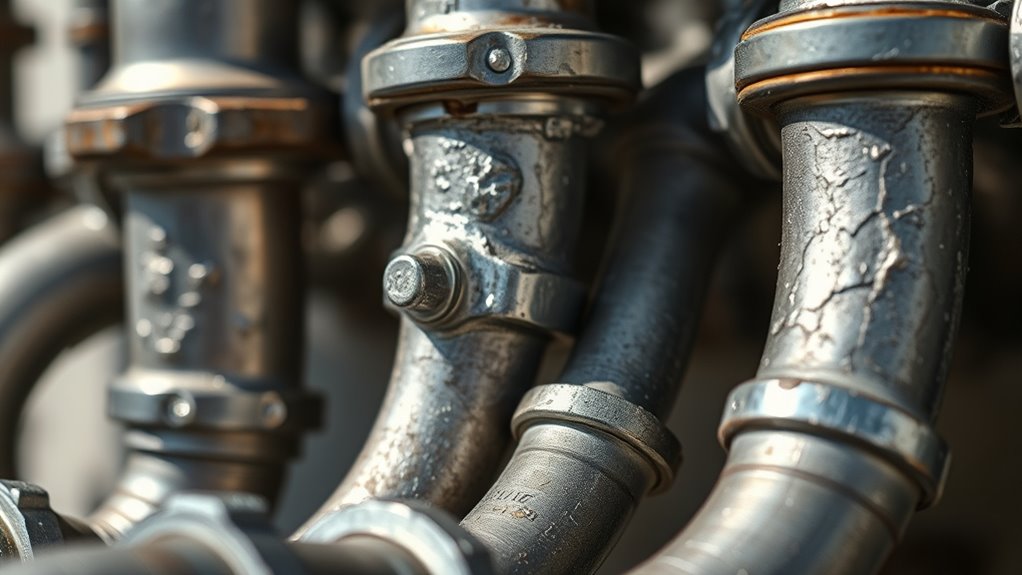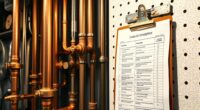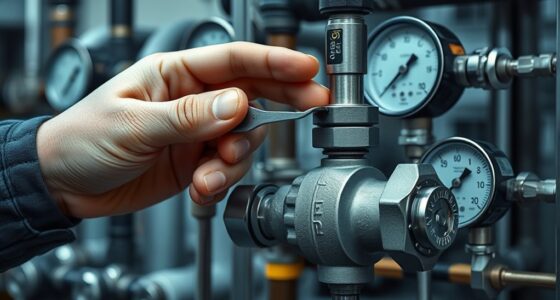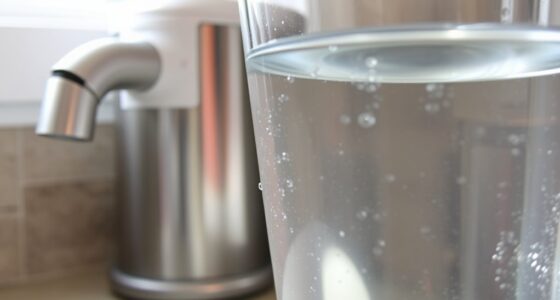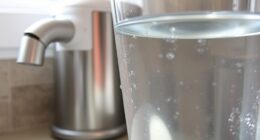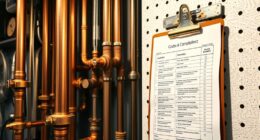When your pipes make noise after maintenance, it’s usually caused by loose fittings, trapped air, high water pressure, or vibrations from flow changes. These issues make pipes rattle, bang, or squeal. Securing fittings, bleeding trapped air, and regulating water pressure can often solve the problem. If you keep experiencing noise, there might be underlying issues that need professional attention. Keep exploring to understand how to keep your plumbing quiet and smooth.
Key Takeaways
- Noisy pipes after maintenance are often caused by loose fittings, vibrations, or trapped air, which can be fixed with proper securing and bleeding air.
- Water hammer, high water pressure, and pipe expansion are common causes of banging or knocking sounds in pipes.
- Using insulation, clamps, and pressure regulators helps reduce vibrations, contact noise, and pipe movement.
- Regularly checking and tightening fittings, and bleeding trapped air, prevent persistent or worsening noises.
- If noises continue or worsen, professional help is needed to diagnose issues like loose fittings, pressure problems, or pipe damage.
Why Do Pipes Make Noise After Maintenance?
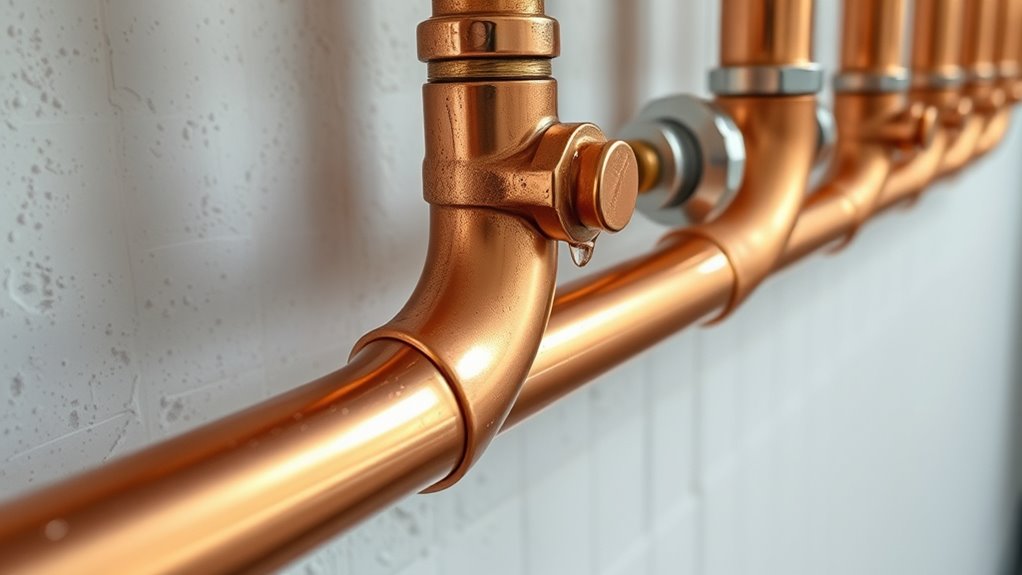
After maintenance, pipes may start making noise because they are often loosened or shifted during repairs. When this happens, the pipes can vibrate or rattle against nearby surfaces, creating noise. Adding pipe insulation helps dampen these sounds by reducing vibrations and preventing direct contact with walls or other structures. Insulation acts as a buffer, absorbing some of the noise and minimizing the rattling effect. Without proper noise dampening measures, you might notice banging, knocking, or humming sounds after repairs. These noises are usually caused by the movement of unsecure pipes or lack of insulation that would otherwise absorb the vibrations. Properly securing and insulating pipes can markedly reduce post-maintenance noise issues.
Common Causes of Noisy Pipes Explained
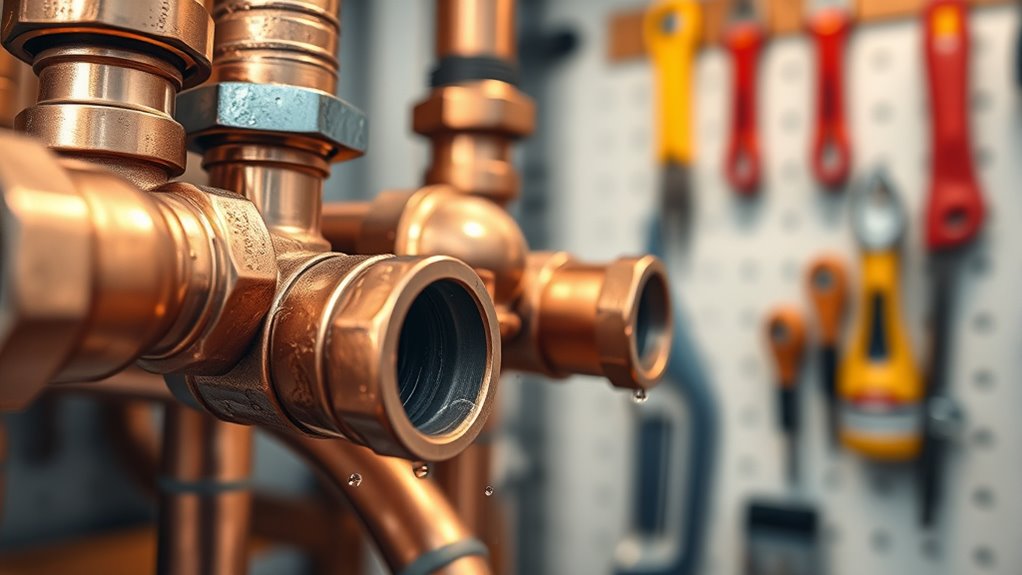
You might notice your pipes making noise after maintenance, and understanding the causes can help solve the problem. Common issues include the water hammer effect, loose pipe fittings, and high water pressure. Recognizing these causes lets you address the noise quickly and prevent future problems. Additionally, automation in business involves the use of advanced technology that can impact plumbing systems by increasing water demand or causing pressure fluctuations.
Water Hammer Effect
The water hammer effect occurs when fast-closing valves or sudden changes in water flow cause pipes to shake and produce loud banging noises. When water flow suddenly stops or shifts, the momentum causes pressure waves to bounce through the pipes, creating that sharp banging sound. To reduce this, you can install pipe insulation, which dampens vibrations and absorbs shock, minimizing noise. Ensuring gradual shut-off valves can also help control water flow speed, preventing abrupt stops. If your pipes are uninsulated, they’re more susceptible to vibration and noise caused by water hammer. Properly managing water flow, using pipe insulation, and installing air chambers or water hammer arrestors can help eliminate these loud, disruptive sounds and protect your plumbing system from damage. Additionally, understanding water pressure regulation can help prevent excessive pressure buildup that contributes to the water hammer effect.
Loose Pipe Fittings
Loose pipe fittings are a common cause of noisy pipes because they allow movement and vibration within the plumbing system. When fittings aren’t tightly secured, pipes can shift or rattle, creating banging or clanking sounds. To reduce this noise, you can add pipe insulation around the loose fittings, which helps absorb vibrations and dampen sound. Properly securing fittings with the right tools and ensuring they’re tight prevents movement that causes noise. Using noise dampening materials or padding around the fittings can also help minimize sound transmission. Regular inspection of fittings, especially after maintenance or repairs, ensures they stay secure and reduces the chances of noise caused by looseness. Keeping fittings tight and well-insulated is key to maintaining a quiet, efficient plumbing system.
High Water Pressure
High water pressure is a common culprit behind noisy pipes, especially after maintenance when fittings are tightened or replaced. When water flow is too forceful, it causes vibrations that travel through your pipes, creating noise. This pressure can also lead to banging sounds if pipes aren’t properly insulated or secured. To prevent this, consider installing pipe insulation to reduce vibrations and noise. You might also want to check your water pressure using a gauge—if it’s above 80 psi, it’s worth lowering it. Proper water flow management helps minimize noise and protects your plumbing system. Regularly monitoring your water pressure ensures it stays within the recommended range and helps avoid unnecessary pipe noise.
The Role of Water Pressure in Pipe Noises
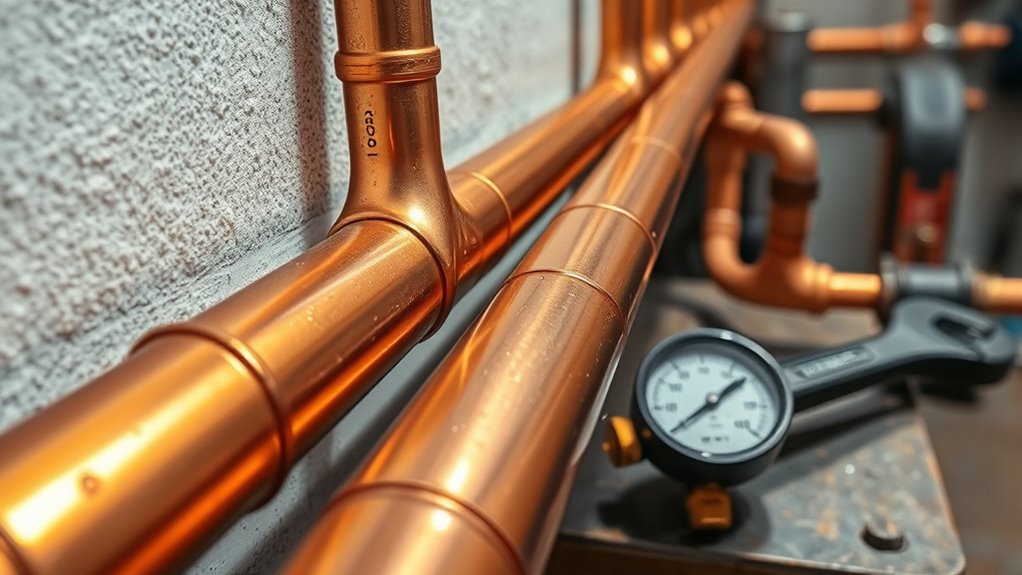
When water pressure inside your pipes becomes too high, it can cause noticeable noises such as banging, whistling, or rattling. This happens because excessive pressure increases water flow speed, putting stress on your pipe material and causing vibrations. These vibrations can lead to persistent sounds, especially if your pipes are made of metal or plastic, which react differently to pressure changes. High water pressure can also cause water to slam against pipe walls, amplifying noise. To manage this, consider installing pressure-reducing valves or checking your current system. Keeping water pressure within recommended levels helps minimize pipe noises and prevents damage. pipe material influences how sounds are transmitted. Increased water flow causes more vibrations. High pressure can lead to pipe rattling. Proper regulation reduces noise and wear.
How Air Gets Trapped in Your Plumbing

Air can become trapped in your plumbing when air enters the pipes through leaks, during repairs, or as a result of changes in water pressure. This trapped air often forms air pockets that disrupt normal water flow. When air pockets develop, they can cause banging sounds, rattling pipes, or other noisy disturbances after maintenance. Trapped air is usually temporary, but it can persist if not addressed properly. As water moves through the pipes, it can push against these air pockets, making them shift or grow, which creates the noise. To fix this, you might need to bleed the air out of your plumbing system or use specific techniques to release trapped air. Removing these air pockets restores quiet and smooth pipe operation.
Loose Fittings and Their Impact on Noise

Loose fittings are a common cause of noisy pipes after maintenance. When fittings aren’t tightened properly, they can vibrate and create banging sounds. You can reduce this noise by ensuring all fittings are secure and tight. Implementing consistent messaging about proper installation techniques can also help prevent recurring issues.
Causes of Loose Fittings
Loose fittings are a common culprit behind noisy pipes after maintenance. When fittings aren’t properly secured, they can vibrate and rattle, creating noise. Several factors cause fittings to loosen over time. Poor installation can leave fittings unstable from the start. Changes in water pressure, especially if water quality fluctuates, can loosen fittings or cause pipes to shift. Insufficient pipe insulation might lead to thermal expansion and contraction, loosening connections. Additionally, aging pipes and fittings naturally wear out, increasing the chance of looseness. Regularly inspecting fittings and tightening them as needed helps prevent noise. Proper installation techniques are essential for securing fittings effectively and avoiding issues. Remember, maintaining proper water pressure and quality, along with secure fittings, keeps your pipes quiet and functional.
Reducing Noise Effectively
To effectively reduce pipe noise caused by loose fittings, focus on tightening and securing all connections. Loose fittings can cause vibrations that amplify noise throughout your pipes. Once secured, consider adding pipe insulation around noisy sections to absorb vibrations and prevent sound transmission. Using soundproof piping or specialized padding can further dampen noise and minimize disruptions. Properly insulated pipes not only reduce noise but also improve energy efficiency. Regularly check fittings and connections, especially after maintenance or repairs, to ensure they stay tight. Incorporating a variety of soundproofing techniques, such as acoustical foam or rubber padding, can further enhance noise reduction. Combining secure fittings with pipe insulation creates a barrier against vibrations and sound, making your plumbing quieter and more peaceful. Consistent maintenance and soundproofing techniques are key to reducing noise effectively and maintaining a quiet home.
Tapping and Banging: What’s Happening Inside Your Pipes
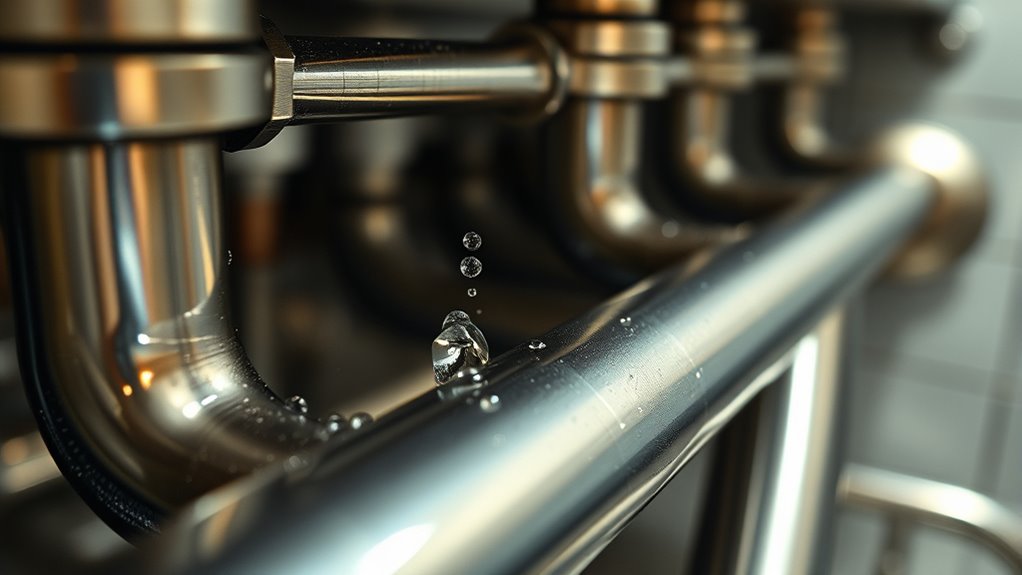
When you hear tapping or banging noises coming from your pipes, it’s usually a sign that something inside them is shifting or expanding. These sounds often happen when water temperature changes suddenly or when pipe insulation isn’t adequate, causing metal pipes to expand or contract. As your water heats up, pipes can move slightly, creating knocking sounds. Sometimes, loose fittings or unsecured pipes amplify these noises. To reduce this, verify your pipes are properly insulated and secured. Pay attention to how hot your water gets, as high temperatures make pipes more prone to movement. You can also check for any signs of loose brackets or fittings that need tightening. Addressing these issues helps minimize tapping or banging, making your plumbing quieter and more stable. Proper pipe maintenance can prevent many common issues that lead to noise.
When to Worry About Pipe Noises
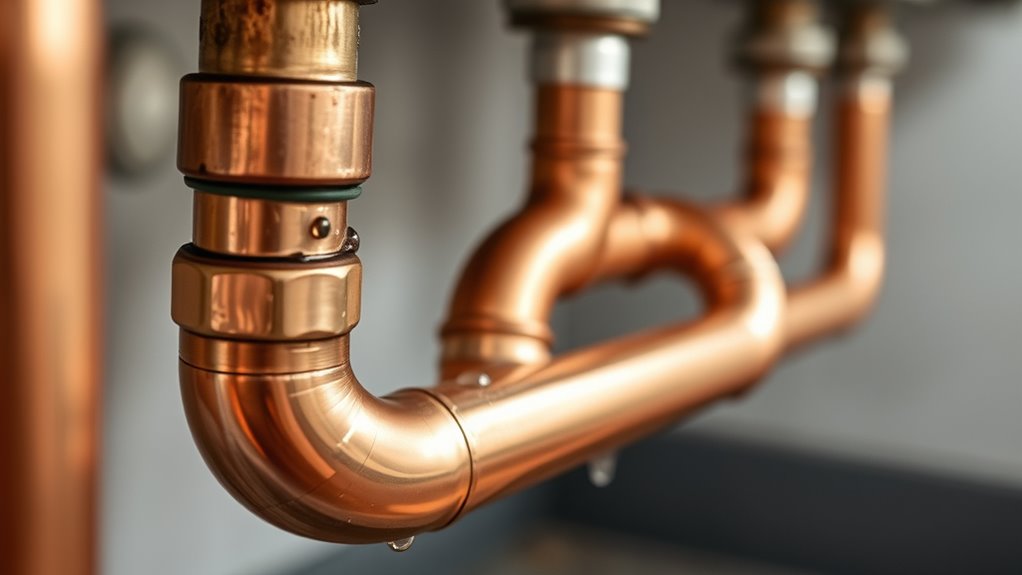
While some pipe noises are harmless, you should start worrying when the sounds become persistent, loud, or suddenly change in intensity. These changes could indicate issues like loose pipes, water hammer, or pressure problems. If you notice banging or rattling, check for loose pipe insulation or missing noise insulation, which can amplify sounds. Persistent squeaking or high-pitched noises may also signal a need for professional inspection. Unusual sounds after maintenance could mean pipes aren’t securely fastened or that there’s an underlying problem with water pressure. Don’t ignore these signals; addressing them early can prevent further damage or costly repairs. When in doubt, consult a plumber to assess whether your pipe insulation or noise insulation needs improvement. Proper soundproofing can help reduce noise transmission and improve your home’s comfort.
Simple Steps to Reduce Pipe Noise at Home
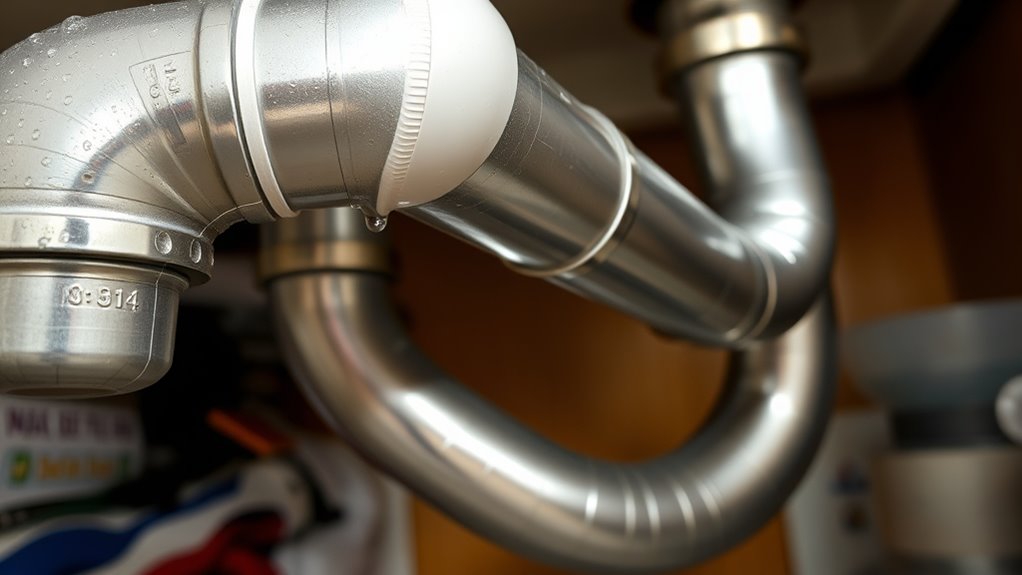
Reducing pipe noise at home is often straightforward and can make a noticeable difference in your daily comfort. You can start by applying pipe insulation around noisy pipes, which dampens vibrations and sound. Additionally, consider using soundproofing techniques like wrapping pipes with foam or rubber sleeves to further reduce noise transmission. Securing loose pipes with brackets or clamps prevents them from knocking against walls or cabinets. Finally, insulating areas where pipes run through walls or floors can prevent sound from traveling between rooms. These simple steps are easy to implement and cost-effective, helping you enjoy a quieter home environment without professional help. With just a few adjustments, you’ll notice less rattling and banging, making your living space more peaceful.
When to Call a Professional Plumber

If your efforts to quiet noisy pipes don’t produce the desired results, it’s time to contemplate calling a professional plumber. Persistent noise may indicate underlying issues like faulty pipe insulation or water pressure problems that need expert attention. A plumber can assess the situation and provide effective noise reduction solutions, such as better pipe insulation or fixing water hammer issues.
Consider this table to help decide when to seek help:
| Noise Type | Potential Cause | When to Call a Professional |
|---|---|---|
| Banging or thumping | Water hammer | If sounds persist after insulation |
| High-pitched squeals | Loose fittings or pressure issues | When DIY fixes fail |
| Continuous rattling | Pipe vibrations or damage | If noise is frequent or worsening |
Don’t delay if simple fixes don’t work—professional help ensures lasting quiet.
Preventing Noisy Pipes During Future Maintenance
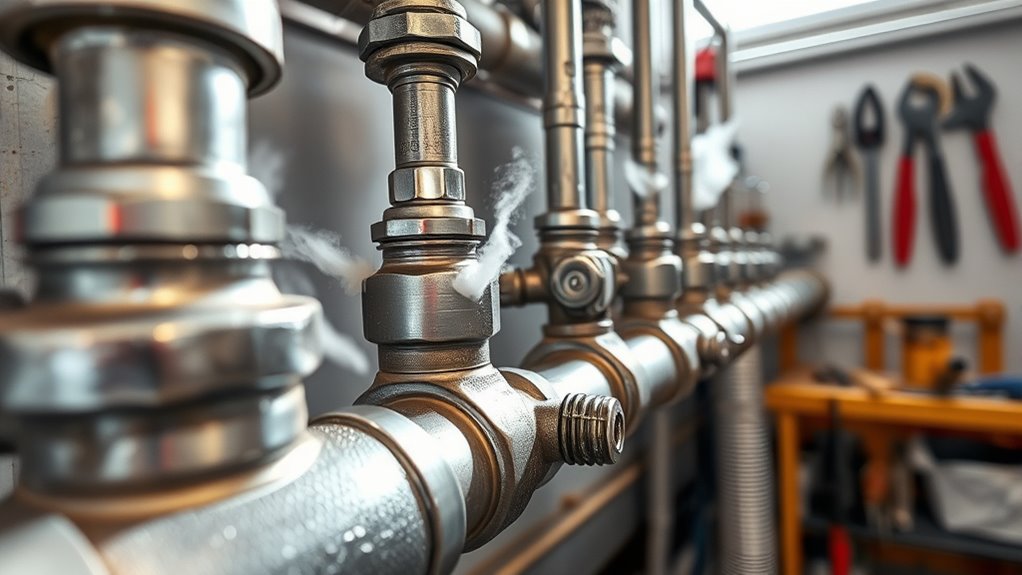
To prevent noisy pipes during future maintenance, you should guarantee proper pipe supports are installed to reduce movement. Installing pressure regulators helps maintain consistent water flow and prevents banging sounds. Additionally, scheduling regular maintenance keeps your plumbing system in top shape and catches issues early before they cause noise.
Use Proper Pipe Supports
Proper pipe supports are essential for preventing noisy pipes during future maintenance. They keep pipes securely in place, reducing vibrations and knocking sounds. Well-supported pipes are less likely to shift or bang against walls or other structures, especially when rerouting or adjusting pipe routes. Using pipe insulation around supports can dampen noise further. When rerouting pipes, ensure supports are correctly positioned to avoid sagging or movement. Proper supports also improve pipe longevity and reduce the risk of damage.
- Choose appropriate brackets or clamps for your pipe size and material
- Space supports evenly along the pipe length
- Use pipe insulation to minimize vibrations and noise
- Secure pipes during rerouting to prevent future rattling
Install Pressure Regulators
Installing pressure regulators can markedly reduce noisy pipes caused by pressure fluctuations, especially during future maintenance. These devices help maintain a consistent water pressure, preventing sudden surges that often cause banging or hammering sounds. When combined with proper pipe insulation, pressure regulators enhance noise dampening, making your plumbing quieter overall. By controlling water flow, they reduce stress on the pipes, minimizing the chances of vibrations and rattling. Ensuring your pipes are well-insulated also helps dampen residual noise, creating a more peaceful environment. Installing these regulators is a simple yet effective step to prevent noisy pipes during future work or changes to your plumbing system. This proactive approach keeps your pipes quieter and decreases the likelihood of disruptive sounds after maintenance.
Schedule Regular Maintenance
Scheduling regular maintenance for your plumbing system is essential to prevent noisy pipes during future work or repairs. Consistent check-ups help identify issues early, allowing you to address problems like loose fittings or worn-out pipe insulation before they cause noise. During maintenance, consider adding or replacing pipe insulation to improve noise reduction. Proper insulation keeps pipes steady and dampens sound, making your home quieter. Regular inspections also ensure water pressure stays balanced, reducing pipe rattling or banging. By staying proactive, you avoid sudden disruptions and costly repairs. Plus, routine maintenance keeps everything running smoothly, extending your plumbing system’s lifespan and maintaining a peaceful environment in your home.
- Inspect pipe insulation for damage or wear
- Tighten loose fittings and joints
- Adjust water pressure if needed
- Use noise reduction techniques during repairs
Frequently Asked Questions
Can Noisy Pipes Cause Water Damage Over Time?
Yes, noisy pipes can cause water damage over time. When pipes vibrate or rattle, it can weaken pipe insulation and joints, leading to leaks. High water pressure or poor pressure regulation worsens this, increasing the risk of damage. To prevent this, make certain your pipes are properly insulated and pressure levels are regulated. Regular maintenance helps catch issues early, avoiding costly water damage caused by pipe failure.
Are Certain Pipe Materials More Prone to Noise Issues?
Imagine the clatter of metal pipes echoing through your home, making you jump at every turn. Some pipe materials, like metal, are more prone to noise susceptibility, vibrating and banging with water flow. PVC pipes, however, tend to be quieter, absorbing sound better. So, yes, certain pipe materials are more prone to noise issues, and choosing the right type can notably reduce that disruptive racket in your home.
How Long Do Pipe Noises Typically Last After Maintenance?
Pipe noise duration after maintenance usually lasts from a few hours to a couple of days. The maintenance effects, like fixing loose fittings or air bubbles, often cause short-term sounds. If the pipe noise persists longer than this, it might indicate a deeper issue. To reduce noise duration, verify all fittings are secure and check for air trapped in the system. Usually, the sounds quiet down as the system stabilizes.
Do Noisy Pipes Indicate Hidden Leaks or Other Problems?
Think of noisy pipes like warning bells—when they squeal or rattle, it might signal hidden leaks or pipe corrosion. Yes, noisy pipes can indicate problems beyond just air in the lines. For instance, if you hear banging after maintenance, it could be a sign of pressure issues or hidden leaks. Addressing these noises early helps prevent costly repairs and water damage, so don’t ignore those sounds.
Can Water Quality Affect the Noise Level in Pipes?
Yes, water quality can affect pipe noise. If your water contains high levels of minerals or sediments, it may cause more turbulence inside the pipes, leading to increased noise. Hard water can also cause buildup that restricts flow, creating vibrations and knocking sounds. You might notice louder pipe noise when water quality declines, making it a good idea to test your water and consider filtration or treatment options to reduce the noise.
Conclusion
Think of your plumbing like a musical instrument. After maintenance, sometimes it hits a wrong note—noises that can be fixed with a little tuning. By understanding what causes these sounds and taking simple steps, you become the maestro of your home’s plumbing symphony. Address issues early, and your pipes will play smooth, quiet melodies for years to come. Keep the harmony, and enjoy a peaceful, noise-free home.
